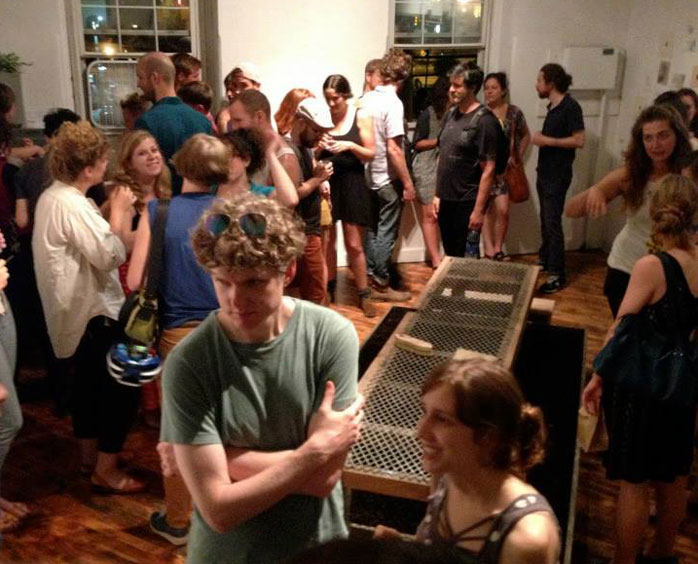“Peripatetic Censor Mechanism” at Practice
The Form Review is a simple attempt to increase dialogue within art journalism and highlight the subjectivity of a traditional exhibition review. Artists/curators/responsible parties of an exhibition are invited to respond to five short prompts. In turn, a representative of the St.Claire views the exhibition and independently responds to the same five prompts. Both sets of “form answers” are published in tandem on the St.Claire website. To participate drop us a line at hark@the-st-claire.com

 Responses by Dave Kyu, member Practice Gallery
Responses by Dave Kyu, member Practice Gallery
1. What is hidden in this exhibition? What is in plain sight?
In plain sight to a gallery visitor is the garden bed & catwalk in the middle of the gallery, and the weeds strung up throughout the space. What’s hidden is how proud we at Practice are to present to you this empty dirt garden bed. After we invited them to make a proposal, Kaitlin Pomerantz of We the Weeds came to us with two ideas: one was a curated group exhibition on botanical works, and the second was this growing experiment based on the writings of Charles Darwin and Edward Salisbury, but was concerned that nothing may grow. Galleries are started for one reason or another, but rarely are they given opportunities that reaffirm everything one wants to do. The threat of an empty garden bed, and thus a failed experiment, didn’t matter to us, not one bit. Our members pay the rent for this space to encourage and allow for artists to take risks on ephemeral, participatory, or performative works without knowing the outcome. 10 days into the exhibition, there is one sprout and one moldy gummy bear in the garden bed, and we couldn’t be more proud to show it to you.
2. Who would be this exhibition’s parents? What might it’s children look like?
The parents of this exhibition would have to be Charles Darwin, who famously cultivated a garden of 80 species from a ball of mud stuck to a wounded French partridge’s leg, and British botanist Sir Edward Salisbury, who grew an entire garden from the botanical debris collected in his trouser cuffs.
Based on personal experience, I tend to think of children as being tangentially similar to their parents in ways they can’t shake, but looking to rebel against those impulses in the search for self definition. On that premise, I’d guess that Tim Hawkinson’s exhibition in 2005 at the Whitney – not the whole exhibition (because how can you compare one room to a landmark exhibition at the Whitney?), but perhaps the room in that exhibition that was showing “Emoter” – would be the resembling, but rebellious child.
3. Describe one moment in this exhibition.
When I walked into the experiment on opening night, Kaitlin of We the Weeds invited me in, and asked if I would like to spread my seed over the planter. For just a moment, I pictured Vito Acconci, masturbating underneath the planter.
4. This exhibition answers the following question:
Quite literally, this exhibition will answer if humans are, almost 50 years later and in a radically urbanized environment, still “peripatetic censor mechanisms, scattering seeds as we walk about” as Sir Edward Salisbury declared. Over 75 visitors have spread their seed over the planter, and as we continue to water this box, time will tell if anything grows.
5. You should message this exhibition if…
You’re kind of into urban farming, but you’re not sure if it’s going to save the world.
If you’ve ever pulled out your pocket lint, and thought it had potential.
If the names Fritz Haeg and Wolfgang Laib get you going.
You’ve re-read Hatchet.
 Responses by Matt Kalasky, Editor The St.Claire
Responses by Matt Kalasky, Editor The St.Claire
1. What is hidden in this exhibition? What is in plain sight?
This exhibition serves to showcase what is hidden in plain sight. That is, the indigenous botanical force that occupies our spaces of neglect. In an urban agenda that is constantly working to pull the seams together, smooth over the cracks, and concrete that which it cannot control weeds are a vibrant reminder of our tenancy of this land.
2. Who would be this exhibition’s parents? What might it’s children look like?
This exhibition is definitely born of scientific inquiry. The deductive mind is at work in a space that feels more like an aestheticized laboratory or a CSA science fair. It’s children might bear the spirit of Johnny Appleseed: Weary urban traveler, you have come through the asphalt wilderness bearing secret precious cargo. Here the seeds of our city are sewn.
3. Describe one moment in this exhibition.
A single green sprout peaks its way out of the gallery’s soil bed. Where did this little guy come from? A crack in the sidewalk on Diamond street? A patch of perfect grass in Rittenhouse Square? A cemetery in Germantown? Maybe New Jersey? Maybe beyond? It is the kind of naturalistic wonder not felt since your 6th grade science class–since the first time you saw a jellyfish–since your last meteor shower.
4. This exhibition answers the following question:
Who are the weeds? The plants or us?
5. You should message this exhibition if…
You are DTP (DOWN TO POLLINATE)
…
WE THE WEEDS team Kaitlin Pomerantz and Zya Levy invite the citizens of Philadelphia to join the investigation by stepping up onto the catwalk of our gallery nursery, shaking out your shoes, and noticing what grows. Let us see if we are indeed “peripatetic censor mechanisms, scattering seeds as we walk about” that Salisbury claimed us to be.
“Peripatetic Censor Mechanism”
An exhibition experiment be We the Weeds
ON VIEW:
August 2 – 24, 2013
GALLERY HOURS:
Saturday: 2:00 pm – 6:00 pm
Practice Gallery
319 North 11th Street, 2nd Floor
Philadelphia, PA 19107
www.practicegallery.org/
